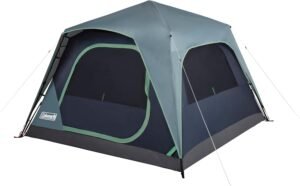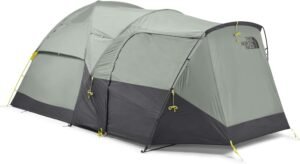The Essential Shelter: A Comprehensive Guide to Camping Tents
A camping tent is more than just a piece of outdoor gear; it’s your portable shelter, your cozy haven amidst the wilderness, offering protection and comfort while you explore the great outdoors. Understanding the nuances of camping tents is crucial for a successful and enjoyable outdoor experience.
In the realm of outdoor excursions, a tent stands as a crucial companion. It shields you from the elements, provides a secure sleeping space, and acts as a retreat from nature’s unpredictability. A well-chosen tent fosters a sense of security, allowing you to embrace the tranquility of the natural world without sacrificing comfort.
Types of Camping Tents
1. Backpacking Tents: Designed for portability, these tents prioritize lightweight construction, compactness, and easy setup, ideal for backpackers and hikers covering long distances.
2. Car Camping Tents: These spacious tents are tailored for campers driving to campsites. They prioritize comfort, offering ample headroom, larger living spaces, and often more elaborate features.
3. Family Camping Tents: Spacious and accommodating, these tents are designed for families or larger groups. They provide multiple rooms, dividers for privacy, and enhanced comfort for extended stays.
4. All-Season Tents: Engineered to withstand harsh weather conditions, these tents excel in durability, wind resistance, and insulation, making them suitable for year-round camping in various climates.
Key Features of Camping Tents
Weather Resistance: A quality tent should offer reliable protection against rain, wind, and sometimes snow. Look for tents with durable materials, taped seams, and waterproof coatings.
Durability: Tents crafted from sturdy fabrics, reinforced stitching, and robust poles ensure longevity, especially in challenging environments.
Setup and Portability: Easy setup, intuitive designs, and manageable weight are crucial, especially for backpacking tents where every ounce counts.
Ventilation: Adequate airflow through mesh panels or vents helps prevent condensation buildup and ensures comfort during warm nights.
Factors to Consider When Choosing a Camping Tent
Capacity: Consider the number of occupants and additional gear space required.
Seasonality: Choose a tent suitable for the weather conditions you anticipate encountering.
Weight and Packability: Important for backpackers and hikers to keep the load manageable.
Livability: Evaluate features like interior space, headroom, and vestibules based on your comfort needs.
Best tents to choose
Selecting the right camping tent is a pivotal step in crafting memorable outdoor experiences. Understanding the various types, key features, and factors to consider allows you to make an informed choice tailored to your specific camping style and needs.
Investing in a reliable, quality camping tent ensures that wherever your outdoor adventures take you, you’ll have a comfortable and secure haven to call your own amidst the wonders of nature.
1. Big Agnes Copper Spur HV UL2
Key Features:
Ultralight Design: Weighs just under 3 pounds, ideal for backpackers and hikers.
Spacious Interior: Offers ample headroom and a floor area of 29 square feet.
Weather Protection: Robust waterproofing and durable materials for varied conditions.
Two Doors/Vestibules: Provides easy access and additional storage space.
Ideal Use: Perfect for solo or duo backpackers seeking a balance between weight and comfort.
Advantages: Easy to set up, lightweight, spacious interior design, and excellent weather resistance.
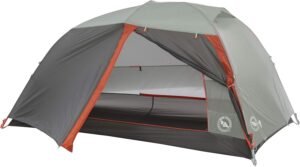
To see more photos and the price please click here…
2. Marmot Tungsten 3P
Key Features:
Spacious Design: Offers ample space for up to three campers, with two D-shaped doors providing convenient access for all occupants.
Weather Protection: Equipped with a waterproof rainfly and durable polyester fabric with taped seams, ensuring protection against rain and moisture. The tent’s robust construction makes it reliable in various weather conditions.
Easy Setup: The color-coded “Easy Pitch” clips and poles facilitate a quick and straightforward setup, allowing for hassle-free assembly, even for beginners.
Excellent Ventilation: Features strategic placement of vents and mesh panels, enhancing airflow and minimizing condensation inside the tent.
Durability: Built to withstand rugged outdoor use, featuring high-quality materials and sturdy construction to ensure longevity.
Advantages:
Versatile: Suitable for various camping styles, from car camping to backpacking trips.
Roomy Interior: Provides enough space for three campers comfortably.
Reliable Weather Protection: Offers excellent resistance against rain and wind.
User-Friendly Setup: Easy to pitch and assemble, even for beginners.
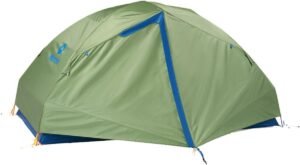
To see more photos and the price please click here…
3. Coleman Instant Camping Tent – Skylodge 4 Person
Key Features:
Quick Setup: Instant setup feature allows for pitching within minutes, ensuring convenience and ease during setup.
Spacious Interior: Accommodates up to four campers comfortably, offering ample room for a small group or family.
Weather Resistance: Durable rainfly and welded floors provide reliable protection against rain and moisture, ensuring a dry interior during inclement weather.
Effective Ventilation: Large windows and a well-ventilated design enhance airflow, reducing condensation and maintaining a fresh interior atmosphere.
Advantages:
Effortless Setup: Quick and easy pitching process suitable for beginners and seasoned campers alike.
Ample Space: Roomy interior comfortably fits four campers, ideal for small groups or families.
Reliable Weather Protection: Withstands rain and moisture, ensuring a dry and comfortable interior.
Enhanced Ventilation: Strategic design elements minimize condensation, keeping the interior fresh and comfortable.
To see more photos and the price please click here…
4. The North Face Wawona 6
Key Features:
Spacious: Provides a floor area of 86 square feet and a peak height of 80 inches.
Family-Friendly: Offers multiple rooms and a removable room divider for privacy.
Durable Build: Sturdy materials and weather-resistant construction.
Large Door and Windows: Enhances ventilation and natural light.
Ideal Use: Designed for family camping trips requiring ample space and comfort.
Advantages: Spacious interior, family-friendly features, sturdy construction, and good ventilation.
To see more photos and the price please click here…
5. Kelty Grand Mesa 2
Key Features:
Affordability: Offers quality features at an accessible price point.
Simple Setup: Color-coded clip construction for easy and quick assembly.
Vestibule Space: Provides a 9-square-foot vestibule for gear storage.
Good Ventilation: Mesh walls for enhanced airflow.
Ideal Use: Suitable for budget-conscious campers seeking reliability and ease of setup.
Advantages: Affordable, straightforward setup, decent vestibule space, and good ventilation.
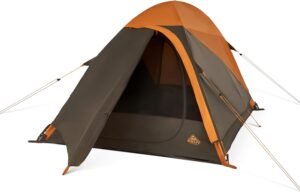
To see more photos and the price please click here…
Conclusion
Each of these tents caters to different camping needs, from ultralight backpacking to family camping, offering distinct advantages in terms of durability, space, weight, and overall usability. Consider your camping style and specific requirements to choose the tent that best suits your adventures!
The Ultimate Guide to Choosing the Best Camping Tent for Your Outdoor Adventures
Are you ready to embark on an unforgettable outdoor adventure? One essential item you’ll need to ensure a comfortable and enjoyable camping experience is a high-quality camping tent. With so many options available on the market, choosing the right one can be a daunting task. But worry not! In this guide, we’ll walk you through everything you need to know to find the perfect camping tent for your needs.
1. Consider the size
The size of your camping tent is crucial. You’ll want to ensure that it offers enough space for you, your camping companions, and your gear. Most tents have a capacity rating, which indicates the number of people it can comfortably accommodate. However, it’s always a good idea to choose a tent that’s one size larger than what you actually need. This extra space will provide room for your belongings and ensure a more comfortable camping experience.
2. Evaluate the seasonality
Camping tents are designed for specific seasons. Understanding the seasonality of your camping trips will help you choose the right tent that can withstand the weather conditions you’ll be facing.
- 3-season tents: These tents are perfect for spring, summer, and fall camping. They offer excellent ventilation, protection from light rain, and can withstand moderate winds.
- 4-season tents: If you’re planning on camping in harsh weather conditions, such as heavy rain or snow, a 4-season tent is your best bet. These tents are built to withstand strong winds, heavy snow loads, and provide better insulation.
3. Look for easy setup and portability
When you’re out in the wild, the last thing you want is to struggle with a complicated tent setup. Look for tents that are easy to set up and take down, preferably with color-coded poles

